
Celestial Snapshots of My Favorite Conjunctions (Op-Ed)
Victor Rogus is an American amateur astronomer and a fellow of the Royal Astronomical Society in London. This is the 10th in his series of exclusive Space.com posts about amateur astronomy. He contributed this article to Space.com's Expert Voices: Op-Ed & Insights.
The word conjunction, as you may remember from English class or Schoolhouse Rock, is a part of speech that connects words, sentences or clauses, a joining or pairing of two or more things. In astronomy, when celestial objects appear to come together, those events are called conjunctions. From the ground, conjunctions seem to show close approaches between planets, or groupings of several celestial objects, at times including the moon or a star. These apparitions are nearly always seen near the ecliptic, the plane the Earth shares with the sun, the path through the sky that is, from our perspective, traveled by the sun, the moon and the planets. That being said, conjunctions are also great photo opportunities that generally require little more than a camera on a tripod setup. What follows are a few of my favorite conjunction photos that I have collected over the years.
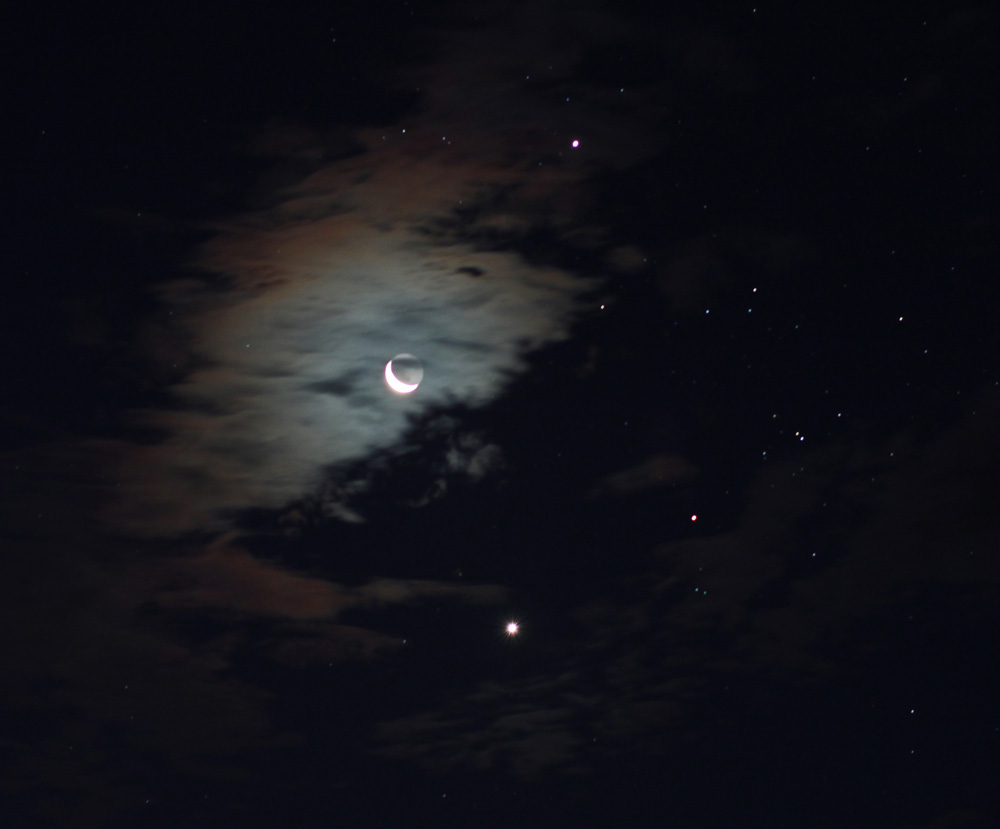
Rain and heavy cloud cover discouraged me from attempting to photograph a beautiful conjunction of Venus, Jupiter and the moon in the constellation of Taurus. It was mid-summer, and there seemed to be no end in sight for rain that night, so I went to bed. Strange the way things happen though; I woke up sometime after midnight to see starlight shining in through the window. Grabbing my bathrobe and slippers, I dashed outside with camera and tripod in hand — looking to the east, I saw a most beautiful sight.
Behind a veil of clouds, the bright planets Venus and Jupiter met like a pair of shy lovers being joined by the moon and the stars of Taurus the Bull. I made my exposures, and watched as the clouds once again changed and the beautiful sight was gone.
Standing in our driveway in bathrobe and slippers, I felt a little bit silly. But it reminded me that sometimes the most beautiful images are so fleeting it pays to be ready at a moment's notice — and don't give up because of a weather forecast. I would rather be rained on (and I have) than miss a beautiful photograph like the conjunction of July 15, 2012.
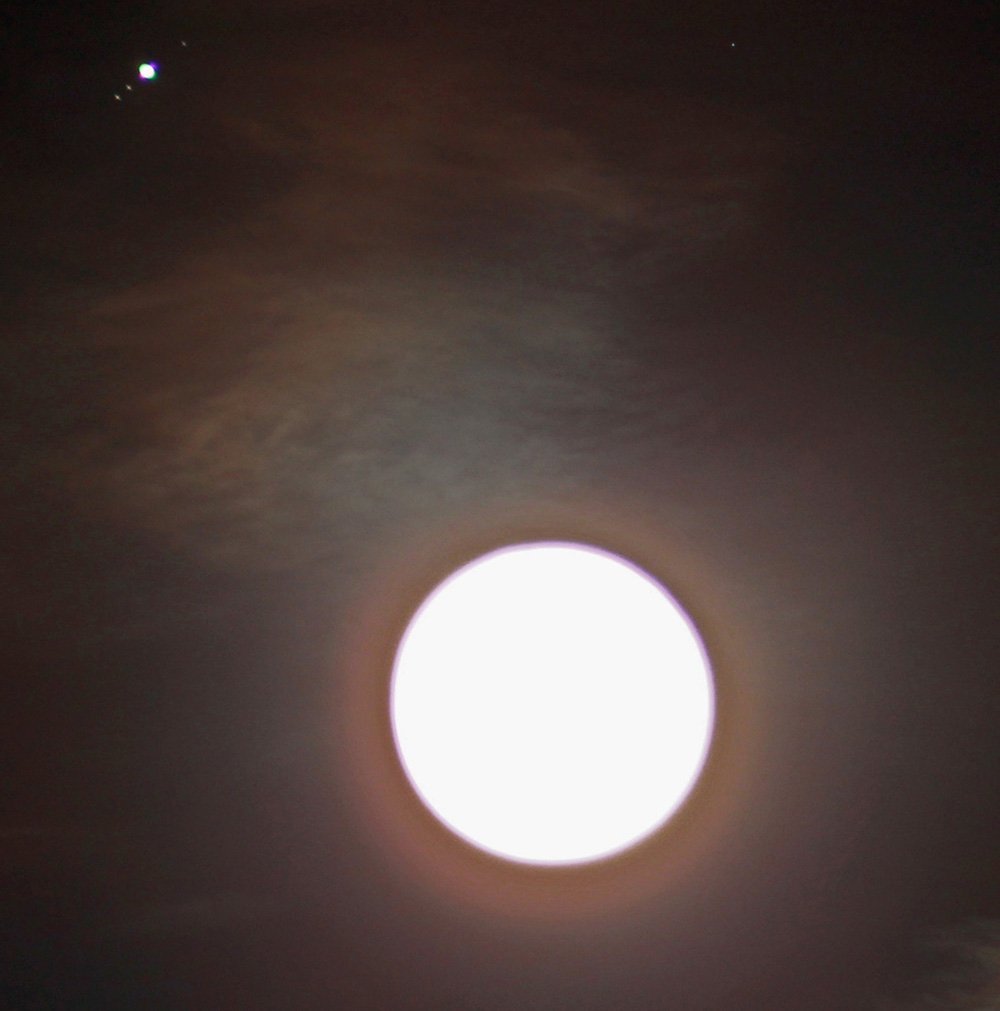
The year 2012 held a series of Jupiter-Moon conjunctions. I made images from each, but this one is my favorite. The moon was nearly in its full phase, and mighty Jupiter held fast less than a degree away. The two fit nicely in the field of view of my 5-inch, f9 apochromatic refractor at prime focus — that is, using the refracting telescope as a huge camera lens with no eyepiece in between the telescope's objective lens and the camera body.
The skies were partly cloudy and the pair ducked in and out of the fast-moving clouds. The overwhelming light of the full moon made exposure selection difficult, until I decided to try and overexpose the image. It was then that I could see the Galilean moons spread out in a plane on either side of Jupiter. It was pretty cool — when Galileo discovered these moons with his primitive telescope, he felt he'd discovered another solar system similar to our own, planets in orbit around their own sun.
Get the Space.com Newsletter
Breaking space news, the latest updates on rocket launches, skywatching events and more!
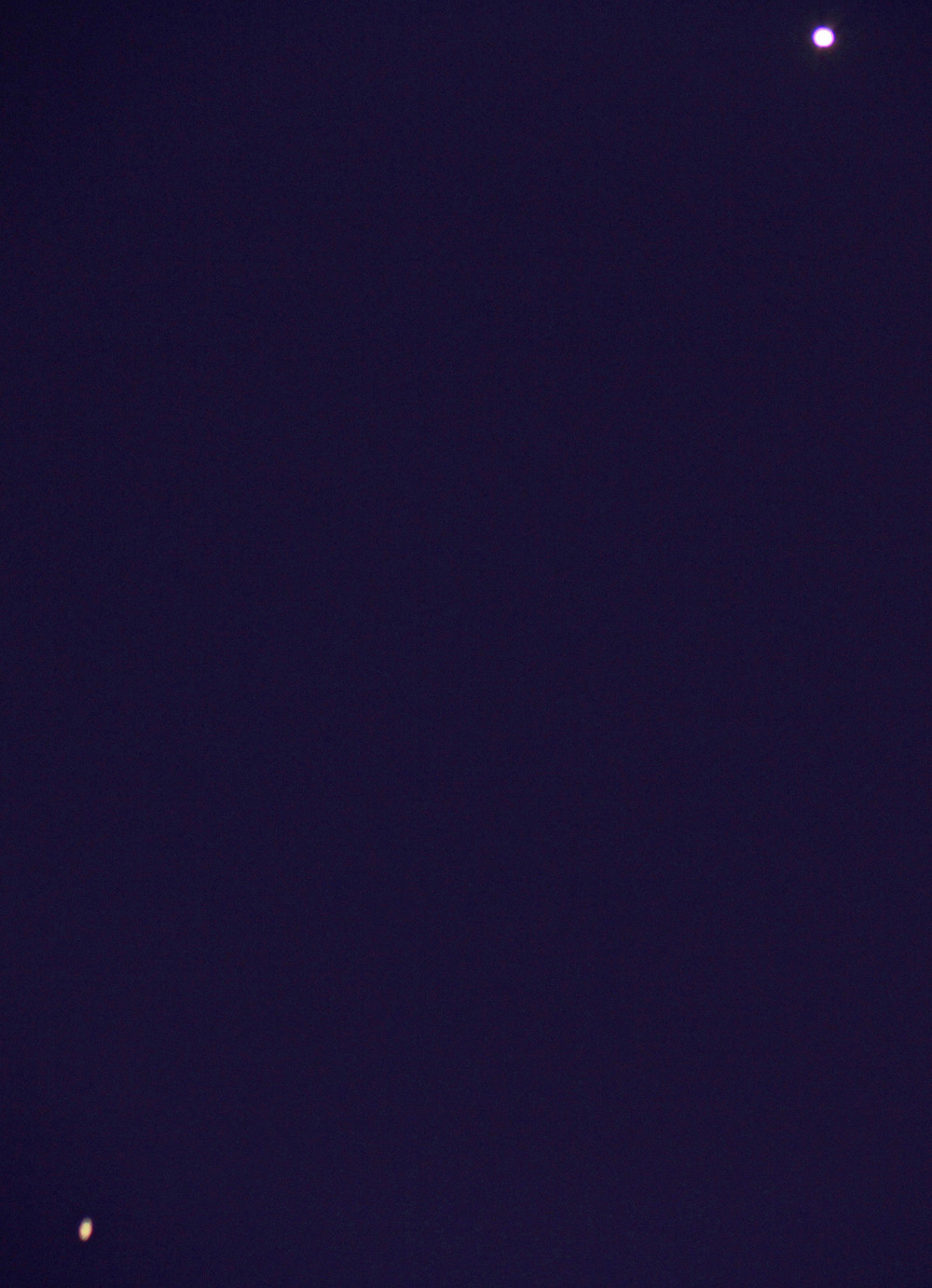
This is another prime-focus image using the same 5-inch refractor, this time on a blue-sky background. At the top right, the inner planet Venus shines bright and round, while in the lower left, the outer planet Saturn appears elliptical in shape and reflecting its signature yellowish light. Through the telescope, they seemed so close together, but in fact they lay some (more or less) 820 million miles apart. This was a wonderful chance to view two planets at the same time in the same field of view.
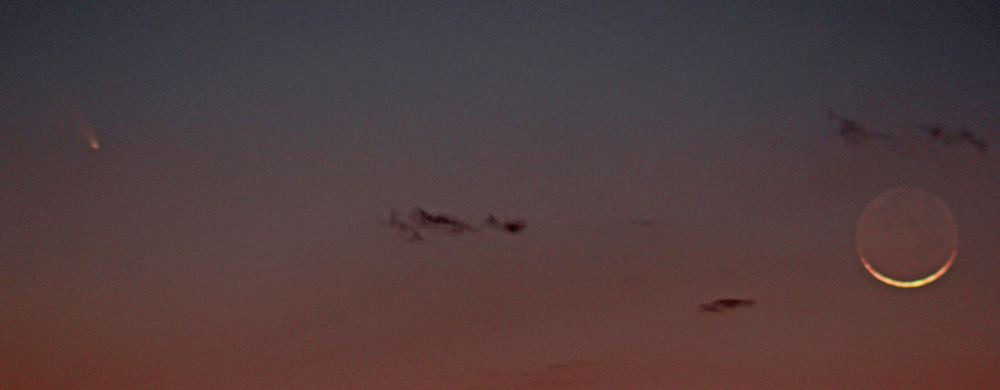
With less than five degrees separation and low in the evening twilight, the famous comet Pan-STARRS (C/2011 L4) paired up with a slender crescent moon. The sky was murky that night, and clouds threatened to obscure the once-in-a-lifetime scene. I knew astrophotographers everywhere had their equipment aimed to the west. Using the moon as a guide, I stood in a cow pasture with camera on tripod scanning desperately for the comet with binoculars — until there it was, the incredible view I had sought, and honestly it gave me chills! Many fine images were made of this event by many fine photographers. This is mine, and I thank my lucky stars the clouds parted long enough for me to capture it. The view did not last long and the pair vanished with the setting sun, as the cloud banks filled in the sky.
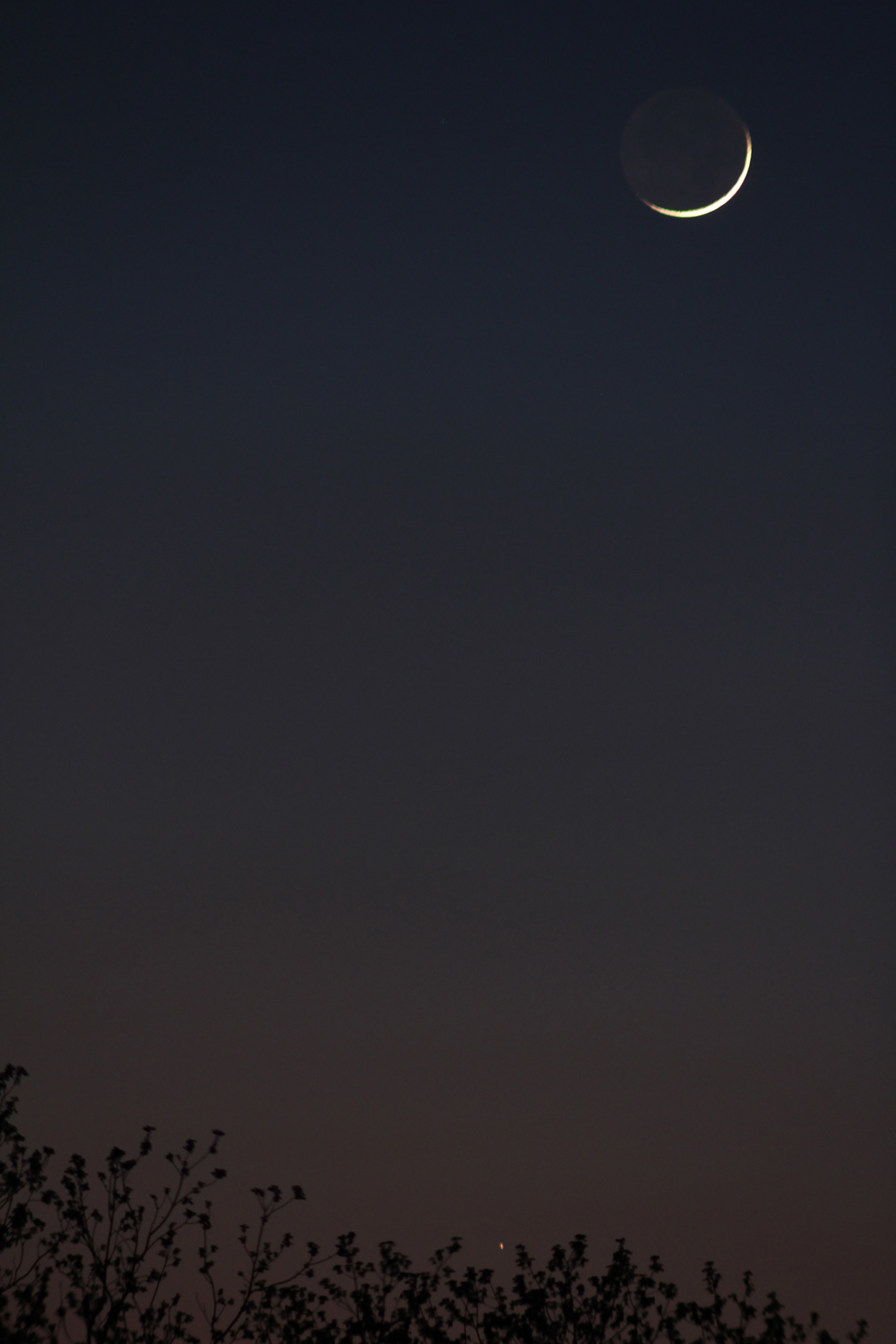
I made this image standing in the same cow pasture I used in the last image. This is a two-day-old moon and the amazing star Aldebaran, seen here at sunset. To me, this image signaled the last of the stars of winter, departing to make way for the stars of spring and summer. The name Aldebaran is from the Arabic for "The Follower," perhaps as a hunter would follow prey. In this case, the prey is Messier object No. 45, also known as the Pleiades — some suggest the Pleiades represent a flock of birds or sheep. Aldebaran is a fascinating star, an orange giant; it is some 150 times brighter than our sun, yet not as hot. It dwarfs our sun and is thought to be 35, or more, solar-diameters larger.
Over the past several months, I've shared my images and stories with Space.com and Live Science with the hope that I inspire those of you who have even the smallest urge to follow the stars. We must each decide just how to do this. I have traveled my path for more than 30 years. And now, all these years later, I feel that I have more questions than answers about the ever changing sky and the latest technology available to study it.
None of us will ever know everything about the stars and how to capture them, it is a humbling fact to accept but that is my point: You do not have to know it all. Just enjoy the sky and let it suggest how you will celebrate your relationship with the heavens.
There are many paths to choose and photography is only one. Start simple, perhaps with a pair of binoculars. Find a dark place, and make time to go there. I always work alone, but others prefer a group outing — I say, "To each their own." With a little effort, you will soon find the sky, day and night, is an incredibly dynamic place where something is always happening. It is anything but an empty void — yet so many of us take it for granted.
If you feel astrophotography is something you might become interested in, go for it — slow and steady. But be warned: It may become a highly addictive and life-changing excursion you are about to embark on!
Rogus' most recent Op-Ed was My Love Affair with the Moon. The views expressed are those of the author and do not necessarily reflect the views of the publisher. This version of the article was originally published on Space.com.
Join our Space Forums to keep talking space on the latest missions, night sky and more! And if you have a news tip, correction or comment, let us know at: community@space.com.
Victor is an American amateur astronomer and a distinguished fellow of the Royal Astronomical Society in London elected to the society in 2014. He's enjoyed photographing and writing about the sky for more than three decades and had his work published in many online sites and publication such as Space.com, Live Science, Astronomy Magazine and many others. He loves to share my work and to see that of others. Victor is also now a member of the American Meteor Society!









